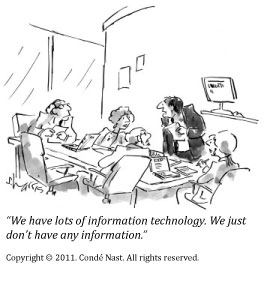
Information Technology Governance Advisory Services for Local Government, SMB and Higher Ed.
Mind the gap!

In the real world, of course, when it comes to minding the gap between the strategic and operational needs of the organization and the tools delivered by IT there are no miracles. As a result, many organizations find themselves caught between the proverbial rock and a hard place!
So, what are organizations to do?
Well, we know what doesn't work—or at least doesn't work very well!

At the other end of the spectrum, large organizations often create formalized, highly-structured, administrative functions for the purpose of ensuring appropriate management oversight of IT project prioritization and spending—typically staffed by senior management and often including administrative support, regularly-scheduled project and budget review meetings, and perhaps even the requirement for IT to produce regularly-updated, organizational-function-specific IT roadmaps.
In practice, neither of the foregoing approaches works consistently well nor does any approach to minding the gap that has "IT oversight" as its underlying purpose. In fact, taking the wrong approach to minding the gap between the strategic and operational needs of the organization and the tools delivered by IT can have unintended consequences. For example, further exacerbating any communication issues or mistrust that may already exist between management and IT!
But we also know what can work—at least in the right circumstances!
ITG emerged in the early 1990s as a sub-discipline within the broader discipline of corporate governance and in response to the growing management challenge of keeping the strategic and operational needs of the organization aligned with rapidly accelerating investments in IT. In short, ensuring that IT investments bring value—whether this value is "soft" or "hard" but in all cases measurable—to the organization.
As for the "...at least in the right circumstances!" bit, introducing ITG into an organization can be daunting. Particularly so for smaller organizations or organizations with unique governance structures and significant financial constraints as is often the case, for example, in professional services firms and in Higher Ed. Nevertheless, the principles of ITG can be leveraged by organizations of any size; whether in the private or public sectors; whether for-profit, not-for-profit, or non-profit; including, as noted above, professional services firms as well as Higher Ed.
But, as is often the case, there are a couple of "gotchas" when it comes to ITG. The first gotcha is that there is no "one-size-fits-all" model when it comes to ITG. In fact, as the old saying goes, a one-size-fits-all model for ITG would be about as useful as a one-size-fits-all shoe! Which is why we created Xprescient in the first place: To help organizations decide if ITG is "right" for them and, if so, help them develop ITG models that reflect their unique organizational challenges and, often even more important, their unique organizational cultures.
The second gotcha is a point emphasized by Gartner in their definition of ITG. While introducing ITG into an organization involves both senior management and IT, at the end of the day ITG is a business investment decision-making and oversight process. Thus, it is a business management responsibility and not something that can be or should be relegated to IT.
There are many definitions of ITG. We find Gartner's definition (http://www.gartner.com/it-glossary/it-governance/) particularly useful as a framework for starting conversations with organizations about whether ITG may be right for them:
[The] processes that ensure the effective and efficient use of IT in enabling an organization to achieve its goals. IT demand governance (ITDG—what IT should work on) is the process by which organizations ensure the effective evaluation, selection, prioritization, and funding of competing investments; oversee their implementation; and extract (measurable) business benefits. ITDG is a business investment decision-making and oversight process, and it is a business management responsibility. IT supply-side governance (ITSG—how IT should do what it does) is concerned with ensuring that the IT organization operates in an effective, efficient and compliant fashion, and is primarily a CIO responsibility.
What's next?
However, whether you choose to talk with us about our services or not, we want to help you evaluate whether ITG might be appropriate for your organization. So, we are continually on the lookout for and providing ITG-related resources that you may find useful. Just click on one of the topics below and be sure to let us know if you have any suggested rerources and/or any questions related to ITG—whether of a general nature or related to your specific organization—where our insight and expertise with respect to ITG can be of help!
-
Let's start with what Xprescient is not! Xprescient is not a traditional consulting firm—although through our advisory services we consult with Local Government, SMB and Higher Ed organizations on issues related to ITG. We are also not a traditional educational institution—although we do both ITG-related education and research.
What we are is an association of like-minded, hghly-experienced, IT-savvy business executives, many of whom have retired from their day-jobs, but who nevertheless remain passionate about both ITG and about helping Local Government, SMB and Higher Ed organizations levarage ITG to help them mind the gap between their strategic and operational needs and the tools being delivered by their IT staffs.
Now, as for our name, the X is "shorthand" for the Latin preposition ex meaning out-of or from. The adjective prescient denotes having or showing knowledge of events before they take place. Combined, they represent our experience-based ability to help Local Government, SMB and Higher Ed organizations anticipate the outcome of their decisions with respect to minding the gap between their operational strategies and requirements and the tools provided by IT.
Xprescient was founded by Duncan B. Sutherland, Jr. Duncan brings to the association more than two decades of ITG-related experience in the public and private sectors including C-level IT leadership roles in business and Higher Ed as well as half-a-decade teaching IT leadership, systems thinking, and change management as a Visiting Professorial Lecturer at The George Washington University School of Business and Public Management.
-
We don't have a "set menu" of advisory services we provide to Local Government, SMB and Higher Ed organizations. Each advisory services engagement is specifically scoped (and priced) to the specific needs (and ability to pay) of a given organization. That said, the kinds of advisory services we are often asked to provide include:
■ General introduction to ITG for senior management and IT (on-line or on-site) ■ ITG deep-dive for Local Government, SMB and Higher Ed organizations (on-line or on-site ) ■ Organization-specific ITG-based assessment of current IT governance practices (on-site or combination of on-site/on-line) ■ Organization-specific collaboration with respect to the development and implementation of an ITG-best practices model (on-site or combination of on-site/on-line) ■ Organization-specific ITG-related research -
We read all of the resources we post. We may or may not agree with a given author's point of view but we still think they are worth a read. So, caveat lector! Click on a resource's title to access the resource and click here to receive a bibliography (PDF) of general ITG-related resources—including links where available.
new!
"IT Governance: Developing a successful governance strategy. A Best Practice guide for decision makers in IT." While published by The National Computing Centre (U.K.) in 2006, and notwithstanding the title's implication that this white-paper is targeted only at IT decision-makers, "IT Governance" is a useful primer offering a comprehensive overview of NCC's take on ITG and remains as relevant today as when it was first published. -
We read all of the resources we post. We may or may not agree with a given author's point of view but we still think they are worth a read. So, caveat lector! Click on a resource's title to access the resource and click here to receive a bibliography (PDF) of Local Government ITG-related resources, or here to receive a bibliography (PDF) of SMB ITG-related resources, or here to receive a bibliography (PDF) of Higher Ed ITG-related resources—including links where available.
new!
"Practice and Politics: IT Governance in Higher Education." Published in 2008 by the Educause Center for Applied Research (ECAR), "Practice and Politics" nevertheless remains highly relevant today because the study reinforces Gartner's point that ITG must be "demand-driven" rather than "supply-driven" to be truly effective. The "supply-side" of ITG was heavily over-represented in the study with 85 percent of the respondents self-identifying as CIOs or equivalent. To Gartner's point, while the majority of the study's respondents were "largely positive" when it came to the alignment of IT with the goals of the organization, almost half of the CIO respondents did not believe that senior management could accurately describe the institution's ITG-related processes! new!
"Company Size Matters: Perspectives on IT Governance." A comparison of ITG practices in large and small (less than 500 employee) businesses published by PWC in April 2011. While focused on Canadian businesses, the study results should be of interest to any small or medium-sized business concerned about minding the gap between the strategic and operational needs of the business and the tools being delivered by IT. new!
"Report: Best Practices Guide for Local Governments." While reports like the "Best Practices Guide" (published by the Center for Digital Government and based on a compilation of 2010 research results) may require registration to download, there is no charge and are generally worth the (minimal) pain. The present report caught our attention because it includes a candid and interesting "case study" of the introduction of ITG in Oakland County, Michigan. -
Xprescient
PO Box 2343
Williamsburg, VA 23187-2343
831.601.5000
info@xprescient.com